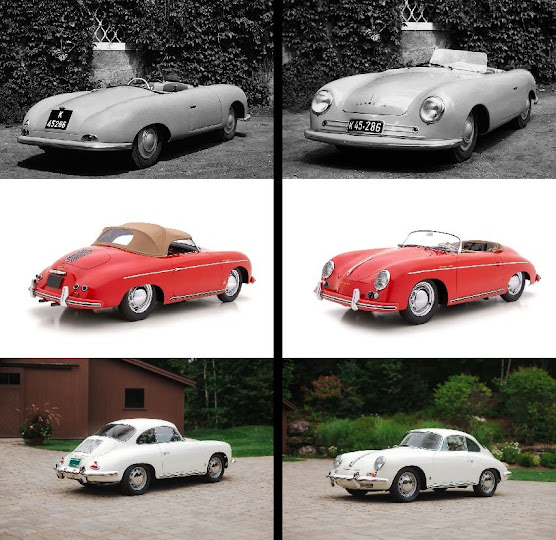Flachkühler (pronounced flak-koo-ler)
In
German, (literally wide cooling device (radiator)), a name adopted by
Daimler-Benz to describe the W111 Mercedes-Benz coupés and cabriolets built
(1969-1971) with a lower, wider radiator grill than the earlier W111 (and W112)
coupés and cabriolets (1961-1969).
Circa
1860s: The construct was Flach + kühler.
The adjective flach (the singular
flacher, the comparative flacher and the superlative flachsten) (shallow (wide and not deep))
was from the Middle High German vlach,
from the Old High German flah, from the
Proto-Germanic flakaz of uncertain
origin. The construct of the noun Kühler ((1) cooler (anything device
which cools) or (2) radiator (of an internal combustion engine) was kühlen + -er. Kühlen was from the Middle High German küelen, from the Old High German kuolōn & chuolen, from the Proto-Germanic kōlōną & kōlēną and
related to kalaną (to be cold). It was cognate with the Hunsrik kiele, the Luxembourgish killen, the Dutch koelen, the Saterland Frisian köile,
the English cool (verb) and the Swedish kyla. The German suffix -er (used to forms agent nouns etc from verbs (suffixed to the verb
stem)) was from the Middle High German -ære
& -er, from the Old High German -āri, from the Proto-West Germanic -ārī, from the Proto-Germanic -ārijaz, from the Latin -ārius.
When used as an adjective, kühler
was a comparative degree of kühl ((1)
cool (of temperature), (2) calm, restrained, passionless and (3) cool, frigid (particularly
of the emotions)), from the Middle High German küele, from the Old High German kuoli,
from the Proto-West Germanic kōl
& kōlī, from the Proto-Germanic kōluz & kōlaz, from the primitive Indo-European gel-. It was cognate with the
Dutch koel and the English cool. Flachkühler
is a noun; the noun plural is Flachkühlers.
1965 Mercedes-Benz 300 SE Cabriolet (Hōchkühler)
The
dimensions of the grill used on the Mercedes-Benz W111 coupé & cabriolet
was dictated by the height of the 3.0 litre (183 cubic inch) straight six (M189; 1957-1967) engine used
in the more exclusive W112 (300 SE) versions.
The M189 was one of several de-tuned variants of the M198 used in the
300SL Gullwing & roadster (W198; 1954-1963) which had started life as the M186 in the
big 300 (W186 & W189, “Adenauer” 1950-1963) saloon before revealing its competition potential by
gaining victories at the Nürburgring, the Carrera Panamericana in Mexico and,
most famously, the 24 Hours of Le Mans.
In the sports cars, the long-stroke six had been installed at an angle
of 50o and fitted with a dry sump which permitted a low hood
(bonnet) line but in the W111 & W112 the engine was in a conventional
perpendicular arrangement and used a wet sump, further adding to the height,
thus the relatively tall grill. The
smaller sixes used in the car (2.2 litre (M127); 2.5 (M129) & 2.8 (M130))
were of a more modern, short-stroke design and didn’t demand such a capacious engine
bay but production line rationalization didn’t make viable two different sets
of coachwork for what were low volume models.
1971 Mercedes-Benz 280 SE 3.5 Coupé (Flachkühler)
By the mid 1960s however, Mercedes-Benz realized their gusty, high-revving sixes were, in higher-priced segments, technologically bankrupt and for success in the vital US market, they needed a mass-market V8. Their big-block 6.3 litre V8 (M100; 1963-1981), introduced in 1963 with the 600 Grosser (W100) wasn’t suitable for down-sizing so a physically smaller range was developed, the first of which was designated M116; released in 1969 and in displacements of 3.5, 3.8 & 4.2 litres, it would serve the line until 1991. The 3.5 came first and in 1969 it was fitted to the W111 coupé & cabriolet. By then, the old 3.0 litre six had been discontinued so the tall grill, which by then had come to look rather baroque, as no longer required and the factory took the opportunity to modernize things and the new, lower wider grill came to be known as the Flachkühler (literally “flat cooler” and best translated as “flat radiator grill”, the engineers deciding the earlier design should be referred to as the Hōchkühler (high radiator). Hōch (high, tall; great; immense; grand; of great importance) was from the Middle High German hōch, from the Old High German hōh, from the Proto-West Germanic hauh, from the Proto-Germanic hauhaz, from the primitive Indo-European kewk-, a suffixed form of kew-; it may be compared to the Dutch hoog, the English high and the Swedish hög.
1968 Mercedes-Benz 280 SE Cabriolet (Hōchkühler, left) and 1970 Mercedes-Benz 280 SE 3.5 Cabriolet (Flachkühler, right).
Because
of the first oil shock in 1973, the plans for mass-market (a relative term)
Mercedes-Benz V8s were interrupted for a while (the W116 350 SE on-sale since 1972) but the 3.5 litre W111s had
already reached the end of the line before the embargo began. Produced only until 1971, they were always
expensive with only 3,270 coupés and 1,232 cabriolets were built and, it being
another age, they were available with a four-speed manual gearbox, an option a
few actually choose. The Mercedes-Benz
manual gear-change was a rather clunky thing but such is rarity value, they
have a cult following. The whole ecosystem
of 280 SE 3.5 coupés and cabriolets is actually a cult in itself, perfectly
restored cabriolets commanding prices in excess of US$500,000 and some German
tuning houses will charge even more for examples modernized with attributes
like ABS, later V8 engines, transmissions and suspension. Even now, although in essence the structure
dates from the late 1950s and the mechanicals a decade later, the appeal
remains because the things are remarkably usable in modern conditions and ascetically,
nothing Mercedes-Benz has made since has anything like the elegance but then, nor have few others. The time of the million US$ 280 SE 3.5 Cabriolet is close.
1953 Morgan Plus 4 ("flat radiator", top left), 1955 Morgan Plus 4 (top right), 1969 Morgan Plus 8 (bottom left) and 2024 Morgan Plus 6 (bottom right). Thematically, not all that much has changed since 1954 although under the skin there is much is the modern Morgan which is "most modern".
Strangely,
the idea of the “flat radiator” had been around for a while in the vernacular
of collector car circles but it referred to another aspect of geometry. In 1952, Morgan of Malvern Link,
Worcestershire, was (as it is now) a cottage industry manufacturing pre-war sports
cars with more modern engines and they received advice from the manufacturer of
their separate headlight assemblies that because MG’s new TF (due for release
in 1953) would have its headlamps integrated into the bodywork, production of
the housing was ending. There being no
alternative supplier, Morgan were compelled to follow MG’s lead restyle things
so the headlamps were faired in.
Concurrent with this, the Morgan factory took the opportunity to do one
of their rare styling changes, abandoning their long-establish upright radiator
grill one mounted in a cowl that blended into the hood (bonnet). It wasn’t exactly the onset of modernity but
there presumably was some aerodynamic gain.
Just to assure buyers change wasn’t being made for the sake of change, disc
brakes would have to wait another few years.
The change to the grill was made in 1953 although, because of the way
Morgan operated, some of the older style cars were actually assembled later
than the new. The cars with the traditional
Morgan look which features the upright grill are known among aficionados as the
“flat radiator Morgans”.
Impromptu Flachkühler: In October 2005, Lindsay Lohan went for a drive in her Mercedes-Benz SL 65 AMG roadster. It didn’t end well, a was a low-speed unpleasantness with a van resulting in her roadster suffering a Flachkühler. Based on the R230 (2001-2011) platform, the SL 65 AMG was produced between 2004-2012, all versions rated in excess of 600 horsepower, something perhaps not a wise choice for someone with no background handling such machinery though it could have been worse, the factory building 400 (175 for the US market, 225 for the RoW (rest of the world)) of the even more powerful SL 65 Black Series, the third occasion an SL was offered without a soft-top and the second time one had been configured with a permanent fixed-roof. A production number of 350 is sometimes quoted but those maintaining registers insist it was 400.






%20Music%20Video%202005.jpg)









